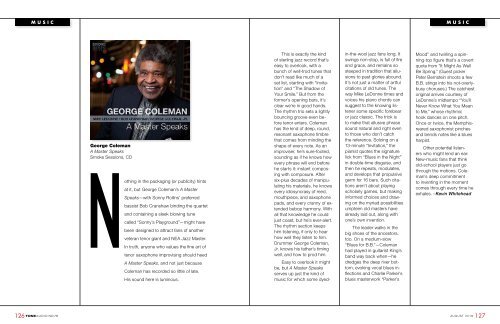You also want an ePaper? Increase the reach of your titles
YUMPU automatically turns print PDFs into web optimized ePapers that Google loves.
MUSIC<br />
MUSIC<br />
This is exactly the kind<br />
of sterling jazz record that’s<br />
easy to overlook, with a<br />
bunch of well-trod tunes that<br />
don’t read like much of a<br />
set list, starting with “Invitation”<br />
and “The Shadow of<br />
Your Smile.” But from the<br />
former’s opening bars, it’s<br />
clear we’re in good hands.<br />
The rhythm trio sets a lightly<br />
bouncing groove even before<br />
tenor enters. Coleman<br />
has the kind of deep, round,<br />
resonant saxophone timbre<br />
that comes from minding the<br />
George Coleman<br />
shape of every note. As an<br />
A Master Speaks<br />
improviser, he’s sure-footed,<br />
Smoke Sessions, CD<br />
sounding as if he knows how<br />
every phrase will end before<br />
he starts it: instant composing<br />
with composure. After<br />
othing in the packaging (or publicity) hints<br />
six-plus decades of manipulating<br />
his materials, he knows<br />
at it, but George Coleman’s A Master<br />
every idiosyncrasy of reed,<br />
Speaks—with Sonny Rollins’ preferred<br />
mouthpiece, and saxophone<br />
pads, and every cranny of extended<br />
bebop harmony. With<br />
bassist Bob Cranshaw binding the quartet<br />
and containing a sleek blowing tune<br />
all that knowledge he could<br />
called “Sonny’s Playground”—might have<br />
just coast, but he’s ever-alert.<br />
The rhythm section keeps<br />
been designed to attract fans of another<br />
him listening, if only to hear<br />
veteran tenor giant and NEA Jazz Master.<br />
how well they listen to him.<br />
Drummer George Coleman,<br />
In truth, anyone who values the fine art of<br />
Jr. knows his father’s timing<br />
tenor saxophone improvising should heed<br />
well, and how to prod him.<br />
A Master Speaks, and not just because<br />
Easy to overlook it might<br />
be, but A Master Speaks<br />
Coleman has recorded so little of late.<br />
serves up just the kind of<br />
NHis sound here is luminous.<br />
music for which some dyed-<br />
126 TONE AUDIO NO.78<br />
in-the-wool jazz fans long. It<br />
swings non-stop, is full of fire<br />
and grace, and remains so<br />
steeped in tradition that allusions<br />
to past glories abound.<br />
It’s not just a matter of artful<br />
citations of old tunes. The<br />
way Mike LeDonne times and<br />
voices his piano chords can<br />
suggest to the knowing listener<br />
some specific forebear<br />
or jazz classic. The trick is<br />
to make that allusive phrase<br />
sound natural and right even<br />
to those who don’t catch<br />
the reference. Soloing on a<br />
13-minute “Invitation,” the<br />
pianist quotes the signature<br />
lick from “Blues in the Night”<br />
in double-time disguise, and<br />
then he repeats, modulates,<br />
and develops that propulsive<br />
germ for 16 bars. Such citations<br />
aren’t about playing<br />
scholarly games, but making<br />
informed choices and drawing<br />
on the myriad possibilities<br />
umpteen old masters have<br />
already laid out, along with<br />
one’s own invention.<br />
The leader walks in the<br />
big shoes of the ancestors,<br />
too. On a medium-slow<br />
“Blues for B.B.”—Coleman<br />
had played in guitarist King’s<br />
band way back when—he<br />
dredges the deep river bottom,<br />
evoking vocal blues inflections<br />
and Charlie Parker’s<br />
blues masterwork “Parker’s<br />
Mood” and twirling a spinning-top<br />
figure that’s a covert<br />
quote from “It Might As Well<br />
Be Spring.” (Guest picker<br />
Peter Bernstein shoots a few<br />
B.B. stings into his not-overlybusy<br />
choruses.) The catchiest<br />
original arrives courtesy of<br />
LeDonne’s midtempo “You’ll<br />
Never Know What You Mean<br />
to Me,” whose rhythmic<br />
hook dances on one pitch.<br />
Once or twice, the Memphisreared<br />
saxophonist pinches<br />
and bends notes like a blues<br />
harpist.<br />
Other potential listeners<br />
who might lend an ear:<br />
New-music fans that think<br />
old-school players just go<br />
through the motions. Coleman’s<br />
deep commitment<br />
to inventing in the moment<br />
comes through every time he<br />
exhales. –Kevin Whitehead<br />
AUGUST 2016 127



